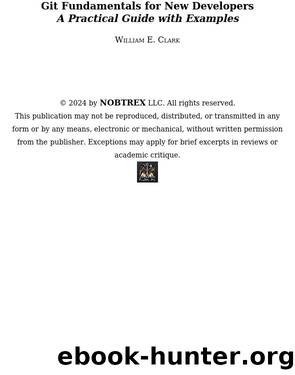Git Fundamentals for New DevelopersA Practical Guide with Examples by William E. Clark

Author:William E. Clark
Language: eng
Format: epub
Published: 2025-04-09T17:35:00+00:00
5.4
â Merging Techniques and Best Practices
Merging is a fundamental process in Git that involves integrating different lines of development into one unified history. It is a key operation that allows developers to combine the changes made in separate branches and ensures that the project evolves cohesively. Merging not only facilitates collaboration among team members who work on isolated features or bug fixes, but it also preserves the integrity of the codebase by creating a seamless record of development. Understanding various merging techniques and best practices is vital for managing a clean commit history and avoiding integration issues.
Merging, in its essence, is the process of combining changes from one branch into another. When developers work independently on separate branches, diverging development paths eventually need to be consolidated. A merge operation retrieves all the changes from the source branch and integrates them with the target branch. This approach ensures that the development history remains comprehensive and that every change is accounted for in the main branch. Merging plays a critical role in maintaining synchronization among various branches, especially in environments where multiple team members contribute concurrently to different tasks.
One commonly used merge strategy is the fast-forward merge. A fast-forward merge occurs when the target branch has not diverged from the source branch; in other words, the branch being merged has all of its changes appended directly from the target branch with no additional commits. When the main branch is simply behind the feature or bug fix branch, Git can update the pointer of the main branch to the latest commit on the other branch without creating an additional merge commit. This strategy maintains a linear history which can simplify version tracking and debugging. However, it is not appropriate in every situation, particularly when an explicit record of the integration is required.
When no divergence has occurred between the two branches, a fast-forward merge can be performed using the following command:
âgit merge <branch-name>
This command updates the current branch pointer so that it now points to the same commit as the branch that is being merged. The linear history that results from a fast-forward merge is easy to follow and can simplify the process of understanding how the code finished in its current state.
In scenarios where the branches have divergedâmeaning that both branches have developed independently and include commits that the other branch does not haveâa three-way merge is necessary. A three-way merge uses the tip of both branches and their common base commit to integrate the changes. This merge operation analyzes all three points: the latest commit on the target branch, the latest commit on the source branch, and the shared ancestor commit. Using this information, Git is able to combine the changes intelligently, even if there are differences that require resolution.
To execute a three-way merge in a situation where a fast-forward is not possible, one can use the standard merge command in Git:
âgit merge <branch-name>
Even though the command is the same as for a fast-forward merge, Git automatically recognizes when a standard three-way merge is needed and performs the appropriate operations.
Download
This site does not store any files on its server. We only index and link to content provided by other sites. Please contact the content providers to delete copyright contents if any and email us, we'll remove relevant links or contents immediately.
What's Done in Darkness by Kayla Perrin(26766)
The Ultimate Python Exercise Book: 700 Practical Exercises for Beginners with Quiz Questions by Copy(20438)
De Souza H. Master the Age of Artificial Intelligences. The Basic Guide...2024 by Unknown(20256)
D:\Jan\FTP\HOL\Work\Alien Breed - Tower Assault CD32 Alien Breed II - The Horror Continues Manual 1.jpg by PDFCreator(20247)
The Fifty Shades Trilogy & Grey by E L James(19233)
Shot Through the Heart: DI Grace Fisher 2 by Isabelle Grey(19220)
Shot Through the Heart by Mercy Celeste(19080)
Wolf & Parchment: New Theory Spice & Wolf, Vol. 10 by Isuna Hasekura and Jyuu Ayakura(17259)
Python GUI Applications using PyQt5 : The hands-on guide to build apps with Python by Verdugo Leire(17197)
Peren F. Statistics for Business and Economics...Essential Formulas 3ed 2025 by Unknown(17041)
Wolf & Parchment: New Theory Spice & Wolf, Vol. 03 by Isuna Hasekura and Jyuu Ayakura & Jyuu Ayakura(16961)
Wolf & Parchment: New Theory Spice & Wolf, Vol. 01 by Isuna Hasekura and Jyuu Ayakura & Jyuu Ayakura(16590)
The Subtle Art of Not Giving a F*ck by Mark Manson(14552)
The 3rd Cycle of the Betrayed Series Collection: Extremely Controversial Historical Thrillers (Betrayed Series Boxed set) by McCray Carolyn(14282)
Stepbrother Stories 2 - 21 Taboo Story Collection (Brother Sister Stepbrother Stepsister Taboo Pseudo Incest Family Virgin Creampie Pregnant Forced Pregnancy Breeding) by Roxi Harding(13930)
Scorched Earth by Nick Kyme(12919)
Drei Generationen auf dem Jakobsweg by Stein Pia(11116)
Suna by Ziefle Pia(11040)
Scythe by Neal Shusterman(10507)
